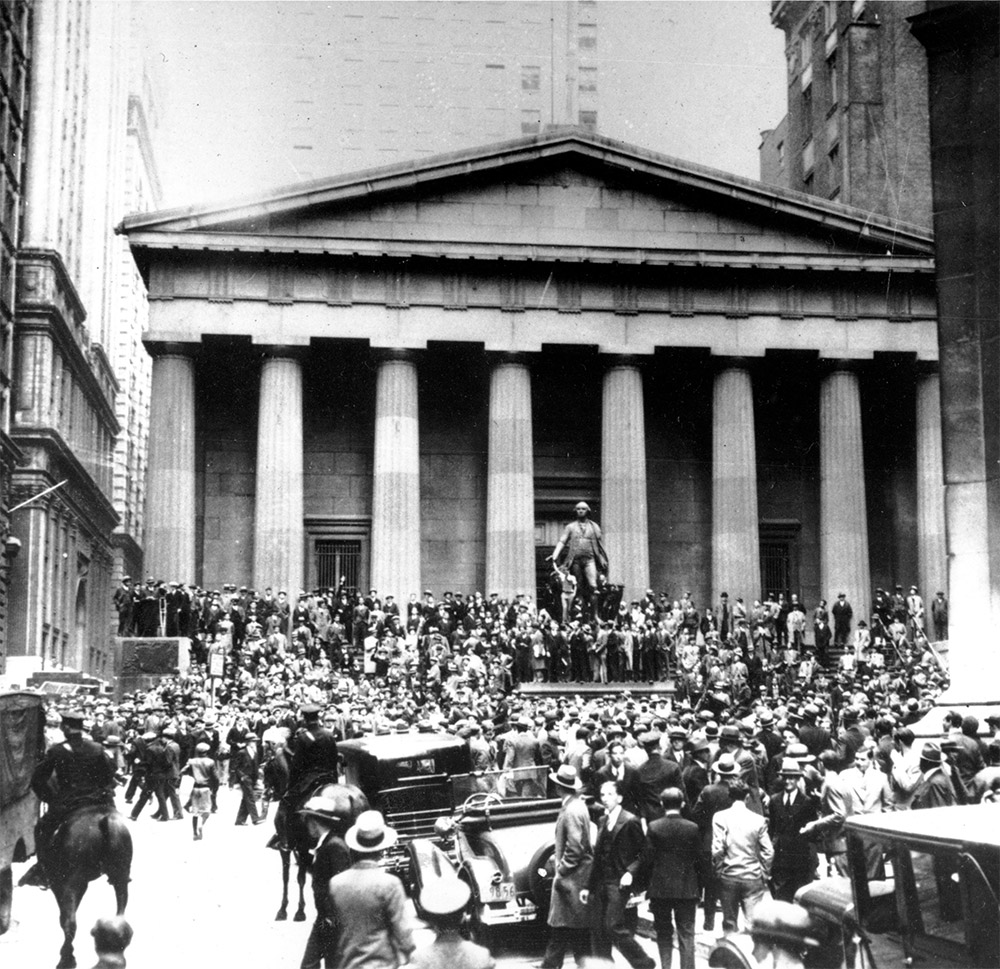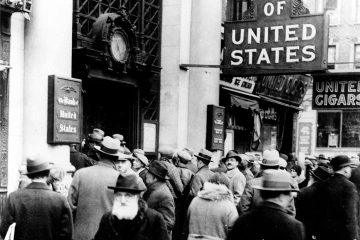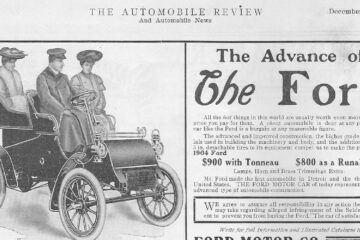What Happened in Business: 1929
| « 1928 | 1930 » |
 Summary: Growth ↑, Then Crash ↓
Summary: Growth ↑, Then Crash ↓
U.S. President: Herbert Hoover
DJIA End of Year Close: 248.48
Top Stocks: United States Steel Corporation, American Telephone and Telegraph (AT&T), General Electric (GE)*
Media: Newspaper, Mail, Magazine, Catalogs, Telegraph, Typewriters, Photography, Telephone, Radio, Phonograph
Wealthy Americans: J. Rockefeller, Andrew Mellon, H. Ford
U.S. Population: 121 million
Era: End of Roaring 20s, Beginning of the Great Depression
Key Events & Dates
Black Tuesday (October 29, 1929):
The stock market crash of 1929, known as Black Tuesday, marks the beginning of the Great Depression. The stock market lost a significant portion of its value, leading to a widespread economic downturn.
Great Depression Begins (Late 1929):
The stock market crash of 1929 triggered the Great Depression, causing massive unemployment, bank failures, and a severe economic crisis that lasted for most of the 1930s.
Prohibition Continues (1929):
The prohibition of alcohol continued in the United States in 1929, leading to the growth of illegal speakeasies and bootlegging operations.
Stock Market Speculation (1929):
Rampant stock market speculation, fueled by easy credit and margin buying, contributed to the bubble that burst in 1929, leading to the stock market crash.
Wall Street Banking Firms (1929):
Many Wall Street banking firms and investment banks were involved in risky financial practices and excessive leveraging, contributing to the financial instability that led to the crash.
Increased Unemployment (1929):
As a result of the Great Depression, unemployment rates soared, leading to widespread economic hardship and social consequences.
Dow Jones Industrial Average (DJIA) Decline (1929):
The Dow Jones Industrial Average experienced a significant decline in 1929, reflecting the loss of investor confidence and the economic challenges facing the country.
Federal Reserve Response (1929):
The Federal Reserve attempted to address the economic crisis by lowering interest rates and implementing monetary policies, but their efforts were insufficient to prevent the deepening of the Great Depression.
The Birth of Mickey Mouse (November 18, 1928, but popularized in 1929):
Mickey Mouse made his debut in the animated short film “Steamboat Willie” in 1928 but became a beloved cultural icon in 1929, signaling the beginning of Disney’s animation dominance.
St. Valentine’s Day Massacre (February 14, 1929):
In Chicago, seven members of the North Side Gang were killed in a brutal gangland shooting, commonly known as the St. Valentine’s Day Massacre, part of the Prohibition-era gang conflicts.
Herbert Hoover Inaugurated (March 4, 1929):
Herbert Hoover was inaugurated as the 31st President of the United States, serving during the critical years leading up to and during the Great Depression.
U.S. Economic Landscape in 1929
The economic landscape in the United States in 1929 was marked by a complex interplay of factors, including a period of economic prosperity known up until that time as the “Roaring Twenties.” However, beneath the surface of this prosperity, there were vulnerabilities and imbalances that would ultimately contribute to the devastating stock market crash of 1929 and the subsequent Great Depression. Here’s a detailed look at the economic landscape:
Prosperity of the Roaring Twenties:
The 1920s was a decade of significant economic growth and cultural change. It saw a booming stock market, increased consumer spending, and a general sense of optimism.
Mass production techniques, pioneered by companies like Ford, led to a surge in manufacturing and the availability of affordable consumer goods, particularly automobiles.
Stock Market Speculation:
The stock market experienced a speculative bubble, with stock prices soaring to record highs. The Dow Jones Industrial Average (DJIA) reached unprecedented levels, attracting millions of investors.
Many investors were buying stocks on margin, meaning they were borrowing money to invest in stocks, assuming that stock prices would continue to rise.
Easy Credit and Margin Buying:
Easy access to credit and margin buying allowed individuals to invest in stocks with borrowed money, further fueling the stock market boom. This created a situation where a significant portion of the market was leveraged.
Industrialization and Urbanization:
The United States continued its path of industrialization and urbanization, with cities growing and the manufacturing sector playing a central role in the nation’s economic growth.
Agricultural Challenges:
The agricultural sector faced difficulties, with falling agricultural prices and overproduction leading to financial stress for many farmers. Rural areas experienced economic challenges.
Income Inequality:
Despite overall economic growth, income inequality was a significant issue, with a small portion of the population holding a large portion of the wealth.
Prohibition:
Prohibition, which banned the sale and consumption of alcoholic beverages, was in effect during this period. It led to the growth of illegal alcohol production and distribution, creating opportunities for organized crime.
Global Economic Interactions:
The United States was increasingly interconnected with the global economy. International trade and foreign investments played a role in shaping the U.S. economy.
Labor Unrest:
Labor strikes and disputes were not uncommon as workers sought better working conditions, higher wages, and the right to unionize.
The culmination of these factors led to the stock market crash of 1929, which occurred on October 29, 1929, also known as Black Tuesday. The crash marked the beginning of the Great Depression, a period of severe economic downturn, widespread unemployment, and financial hardship that lasted throughout the 1930s. It was a pivotal moment in U.S. economic history, underscoring the importance of regulation and financial stability in the financial markets.
Consumer Brands of the Era
In 1929, several consumer brands and products were well-established in the United States. These brands represented various industries and sectors of the economy. Here are some notable consumer brands from that year:
Coca-Cola:
Coca-Cola, the iconic soft drink, had become a household name. It was one of the most popular beverages in the United States and had a strong presence in the global market.
Ford:
The Ford Motor Company, founded by Henry Ford, was a dominant force in the automotive industry. The Model T had been replaced by the Model A, which continued to be a popular choice among consumers.
General Electric (GE):
General Electric was a leading brand in electrical appliances and lighting. It produced a wide range of products, from refrigerators to light bulbs.
Procter & Gamble (P&G):
Procter & Gamble was known for its consumer goods, including soap products like Ivory and laundry detergent brands such as Tide.
Kellogg’s:
The Kellogg Company was a prominent name in the cereal industry, with brands like Corn Flakes and Rice Krispies gaining popularity among breakfast consumers.
Chevrolet:
Chevrolet, a division of General Motors, was known for its automobiles. The Chevrolet brand was a strong competitor in the automotive market.
Pepsi-Cola:
Pepsi-Cola was a significant competitor to Coca-Cola in the soft drink industry. The Pepsi brand had been around for several decades and continued to grow.
RCA:
The Radio Corporation of America (RCA) was a leading brand in the radio and electronics industry. It manufactured radios and other electronic equipment for consumers.
A&P (The Great Atlantic & Pacific Tea Company):
A&P was a major retail and grocery store chain. It was one of the largest grocery store chains in the United States at the time.
Wrigley’s Chewing Gum:
Wrigley’s chewing gum, including brands like Spearmint and Juicy Fruit, was popular among consumers as a chewing gum brand.
Campbell’s Soup:
Campbell’s Soup was known for its variety of canned soups, with its red and white labels becoming a familiar sight in households.
Nabisco:
The National Biscuit Company (Nabisco) was a well-known brand for biscuits, cookies, and crackers. Products like Oreo cookies and Ritz crackers were introduced by Nabisco.
These consumer brands represented a mix of food and beverage, automotive, electronics, and household products, reflecting the diversity of consumer goods available in the United States during the late 1920s. Many of these brands continue to be prominent and enduring today.
Key Leaders, Innovators, & Influencers of the Era
In 1929, there were several important business leaders and influencers who played significant roles in shaping the business landscape of the United States. Here are some notable figures:
John D. Rockefeller, Sr.:
Although he had officially retired from the oil industry, John D. Rockefeller, Sr., remained one of the most influential figures in American business history. His past role in Standard Oil and philanthropic endeavors continued to impact various sectors.
Henry Ford:
The founder of the Ford Motor Company, Henry Ford, was a pioneer in the automotive industry. He played a vital role in making automobiles affordable and accessible to the masses.
Andrew Mellon:
Andrew Mellon was a prominent banker, industrialist, and financier. He served as the U.S. Secretary of the Treasury from 1921 to 1932 and played a key role in shaping economic policy during the 1920s.
Alfred P. Sloan, Jr.:
Alfred P. Sloan, Jr., was the president and chairman of General Motors (GM). He was known for his leadership in modernizing GM and making it one of the world’s largest and most profitable corporations.
Charles Lindbergh:
While not a traditional business leader, Charles Lindbergh’s historic transatlantic flight in 1927 had a significant impact on the aviation industry and commercial aviation.
Thomas Edison:
Although Edison was well into his later years by 1929, his legacy as an inventor and entrepreneur continued to influence the electrical and technology sectors.
William Randolph Hearst:
William Randolph Hearst was a media magnate who owned a vast newspaper and media empire. His influence in the newspaper industry was substantial.
Walt Disney:
Walt Disney co-founded The Walt Disney Company in 1923 and introduced the character Mickey Mouse in 1928. His contributions to animation and entertainment were just beginning in 1929.
Herbert Hoover:
Herbert Hoover, who would later become President of the United States in 1929, was an influential figure in the mining industry and humanitarian efforts. His presidency coincided with the onset of the Great Depression.
Owen D. Young:
Owen D. Young was a prominent businessman who played a crucial role in the Young Plan, an agreement to address reparations and economic issues stemming from World War I.
These business leaders and influencers were instrumental in various industries and sectors, contributing to the economic and social landscape of the United States during the late 1920s. Their actions and decisions had far-reaching effects on the nation’s economy and society.
* Stocks are examples of some of top, popular traded stocks; however, exact data not available.
| « 1928 | 1930 » |


